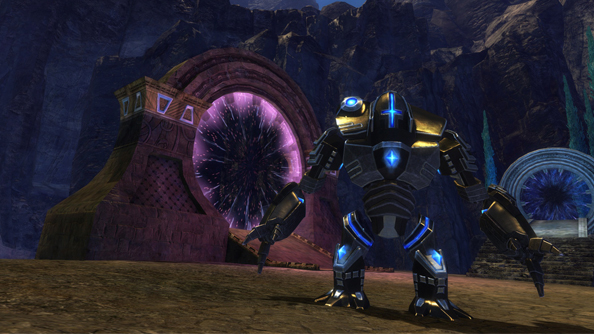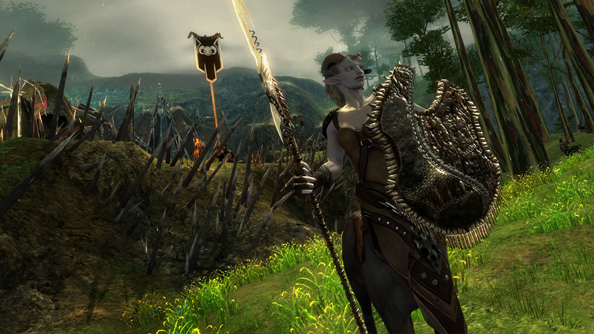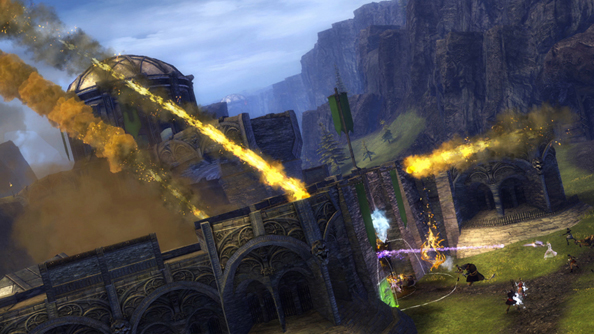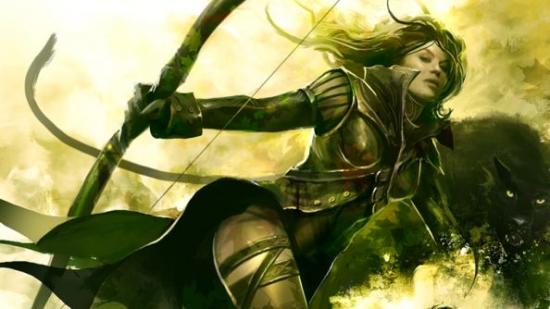There’s always been something of the saviour about Guild Wars 2. False prophets have come and gone, and each time the thronging masses of the gaming public has held their collective breaths, wondering if perhaps this would be the one to free them of the tyrannical, all encompassing rule of World of Warcraft. Whether this would be the one to break past the first few million subscribers and cast them free of those heavy shackles that they must bear. The thronging masses of the gaming public always were prone to melodrama.
Want to know more about Guild Wars 2?We’ve got previews of individual character classes: Guardian, Necromancer, Engineer, Thief, Elementalistand Mesmer
It has a hell of a lot going for it, which makes the baited breath that follows the game around somewhat understandable. No subscription fee with an open world makes it instantly attractive, and when quite so much of the game is quite so innovative, it’s the kind of game that makes you start to scratch your head and wonder how it’s only nowthat we’re getting to experience something like this.
There’s a contradiction at the center of how Guild Wars 2 works, at least in the PvE, though. While Arenanet clearly wants the game to be phenomenally successful, and by all means it should be, what you don’t want is for your server to be phenomenally popular. You want it to be just popular enough.
Much has been made of the dynamic quest system, where first Arenanet stripped out quest givers, and then they made the results of your actions actually ripple throughout the zone you were in, so that you actually feel like you’re having some impact. The example of the Centaurs of Queensdale destroying farms and villages has been used to illustrate this, claiming that if you were to allow these rampaging, tribal horse bastards to destroy and pillage the farms, you’d not have people to sell things to, or repair your armour, and the whole place would be occupied by an aggressive, hostile force with hooves and hands.
However, if you push them back, and keep pushing them back, eventually you’ll find yourself up against a Centaur Warlord, and once he’s dead, the Centaurs will have a meeting to decide who their next cheiftan will be, before sallying forth again to murder and pillage. That’s the brief.
It doesn’t quite play out like that, but then it was always a little unreasonable to think it would be that intricate throughout. What is there, however, does live up to a lot of that promise. There are still regular, difficult attacks on trade hubs and safe zones. People do require you to stop them from getting slaughtered, and if they do, help them back onto their feet with nebulous resurrection magic. And you can push back attacking forces with a series of dynamically generated public quests that react to player input and success.
But that’s where that contradiction flared up. Playing during a beta weekend, and the first beta weekend that anyone could join, so long as they ponied up the cash for a pre-purchase of the game, the servers were heaving with players. Every public event had well over the optimum amount, meaning that the only dynamic condition you ever got to see was the Great Success end of the spectrum. The Centaurs always got pushed back. The Safe Zones never got properly taken away. Especially in the starting areas filled with lower level players, it was a great horde released among the poor, unprepared NPC mobs, and they died by their thousands.
The longer I spent playing, the less people were clamouring for the public quests, and the more dynamic they started to become. A Nord trading post was overrun by The Sons of Svaldir, the main opponent to your progress in the Nord areas. We were throwing ourselves at them, but there were too many for the ten or so of us trying to clear it, and with our armour getting banged up each time we died, and the armoursmith who could repair it lying dead at the feet of these attackers, we ended up increasingly naked, and increasingly futile in our attempts to recapture it.
But when we put out a call in general chat, it became something different. People want the unexpected, and the dynamic, and to join in on this emergent reclamation of something that should, by rights, be ours, it became the highlight of the weekend for me. We’d rush forth, pushing the Sons back, giving us just enough breathing room to grab some of the friendly NPCs and pull them to their feet, and /maybe/ repair our armour, before the Sons would attack again and we’d be pushed back once more. Eventually we reclaimed it, and the rag-tag group we’d formed stuck together for half an hour or so, running through the quests in the area. Silent brothers in arms.

It’s one aspect in Arenanet’s Trident-like approach to Guild Wars 2. While most people will flock to such PvE content, there’s also a really quite solid single player contingent, giving you a personal story to invite your friends into, and make choices within. And then there’s the World versus World versus World part, which was hammered the whole time because it’s by far the most ambitious of all of GW2’s systems.
It’s this that is most indicative of what Guild Wars 2 is going to be. This is a game where there should be absolutely no downtime between doing things, and nothing that has you minimising it to browse forums or watch Youtube videos while you wait for… whatever. If you get bored of mucking about in PvE, do your next story mission. Bored of that? Then head over to the PvP, whether in WvWvW or in the more formal battlegrounds. That’s on the macro level, but it also applies in increasingly smaller ways.
You’re constantly unlocking waypoints as you explore the world, and (for a really quite modest fee) you can teleport between any of them, instantly, at will. You don’t even have to get to your nearest one to instigate a teleport. You just open the map and click, meaning that the instant you get bored of any one area, or need to head over to the other side of the world to play with your friend, you can. Just so long as you’ve explored enough.
Even more impressively, if you want a change of scenery from this one level fifteen area, and you’ve just about finished all of the rest of the level fifteen content, you can head back to a level ten area that you missed out on, automatically dropped down to level ten so that there’s still a challenge there, and all rewards will then bump themselves up to your level fifteen stats. Every little part of the game is about /avoiding/ segregating both their community and their content. ‘Level appropriate’ is a guide in the most general sense of the term.
Once you’ve started to notice these systems it’s difficult not to keep picking at the thread that makes up the wooly jumper of Guild Wars 2. I want to regale you with how the guesting works, where you can head over to any other shard to play with friends on other servers, or tell you all about how getting rid of the Holy Trinity of Tank, Healer and DPS has meant you spend no time waiting for a perfect group configuration. There are a hundred little touches like this that just make sense, in the most wonderfully intuitive way. It behaves how you want it to behave.
And that, fundamentally, is what is going to define Guild Wars 2. It’s a massive sigh of relief, once you’re ten minutes in and you realise that there is so much faffthat you don’t have to deal with ever again. It’s not the messiah, though, and it probably won’t kill World of Warcraft. But then, did it ever really need to? This town is more than big enough for the both of them.
Want to know more about Guild Wars 2?We’ve got previews of individual character classes:Guardian,Necromancer,Engineer,ThiefandMesmer
